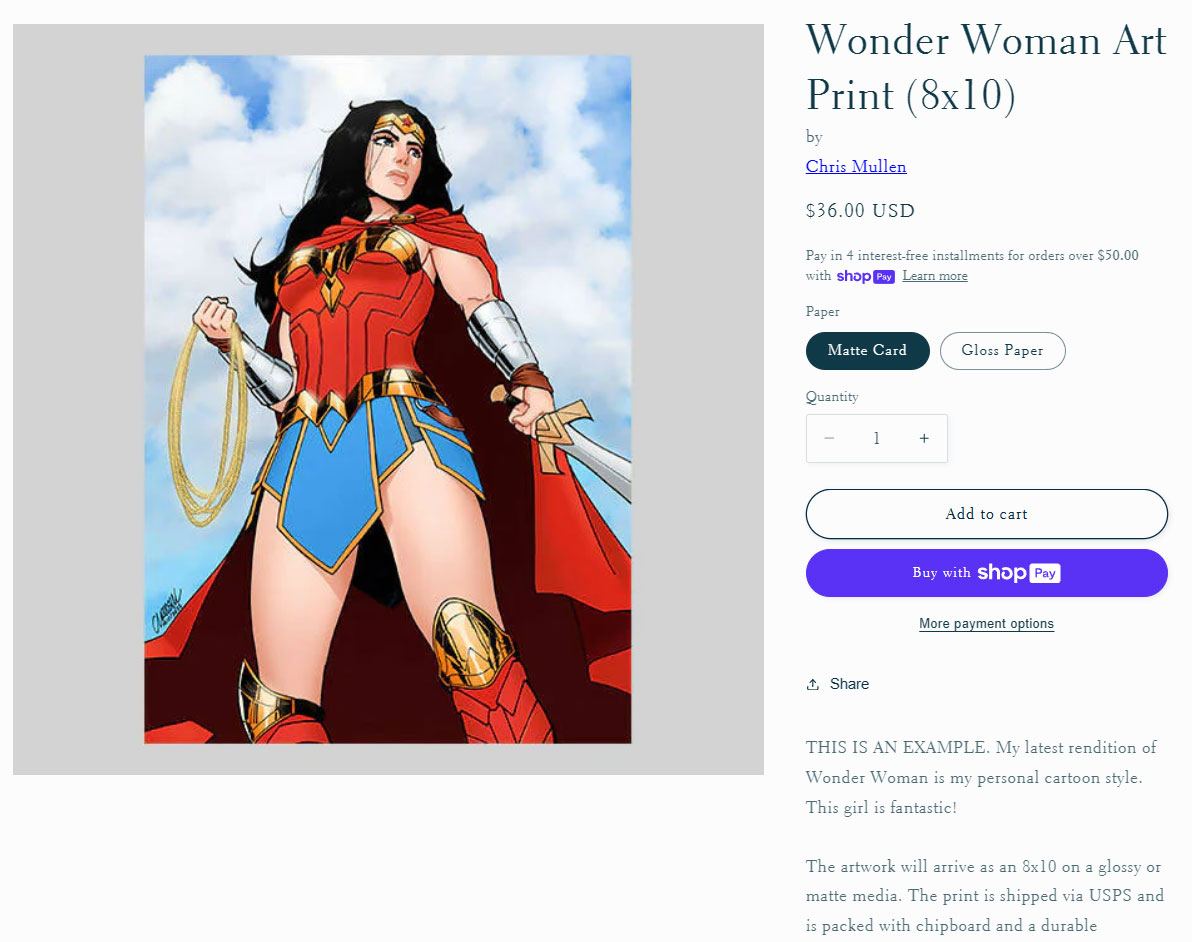When listing your handmade products at Printkeg.ART, you want to ensure the customer understands precisely what they are receiving.
Here is an example of a decent listing:

The Most Important parts of your listing…
TITLE – The first thing to note is the title or PRODUCT NAME. If a customer orders this product, she knows she ordered an 8×10 print of Wonder Woman. The seller chose to add “8×10” so the customer understands the exact size of the print.
OPTIONS – The seller offers the Wonder Woman print on two paper types – Gloss and Matte. Sellers can offer different options by using the variances feature while creating a listing. We highly recommend adding options to your listings.
DESCRIPTION – There should be a decent description at the bottom. Well-written descriptions will help people discover your items more easily as our marketplace grows. In this case, the seller would have added more information about the paper types (gloss and matte). Try to input at least 250 words in this area.
IMAGES – We recommend at least two to three images, but this seller chose only to provide one.
More tips for better listings…
Quality Photos
- Multiple Angles: Show your product from many angles, including close-ups and contextual shots.
- High Resolution: Ensure your images are clear and high-quality.
- Well-Lit: Use natural or professional lighting to make your product look its best.
- Styled Shots: Show the product in use or styled with other items to help buyers visualize its use.
Compelling Titles
- Keywords: Use relevant keywords that buyers might search for.
- Descriptive: Clearly describe the product, including the main features and benefits.
- Avoid Repetition: Don’t repeat words unnecessarily; keep it concise yet informative.
Detailed Descriptions
- Key Features: List the product’s features, dimensions, materials, and any variations (color, size, etc.).
- Benefits: Explain how the product can be used and what makes it unique or valuable.
- Care Instructions: Include information on how to care for or maintain the product.
- Storytelling: Share the story behind the product or your brand to create a personal connection.
Appropriate Tags
- Relevant Keywords: Use all 13 tags available with relevant search terms.
- Variety: Include different variations of keywords and phrases to reach a broader audience.
- Niche Terms: Use specific terms that target your niche market.
Pricing
- Competitive: Research similar items to set a competitive price.
- Value: Ensure the price reflects the value and quality of the product.
- Transparency: Include any additional costs like shipping or customization.
Inventory Management
- Stock Levels: Keep your stock levels updated to avoid overselling.
- Variations: Clearly list available variations (sizes, colors) and manage their stock individually.
Customer Reviews
- Encourage Reviews: Politely ask satisfied customers to leave reviews.
- Respond Promptly: Respond to reviews, especially negative ones, professionally and helpfully.
SEO Optimization
- Keywords: Use keywords in your titles, descriptions, and tags to improve search visibility.
- Synonyms: Include synonyms and related terms to capture different search queries.
- Updates: Regularly update your listings with new keywords and trends.
Policies
- Clear Policies: Post clear shop policies regarding returns, exchanges, and cancellations.
- FAQs: Include a Frequently Asked Questions section to address common concerns.
